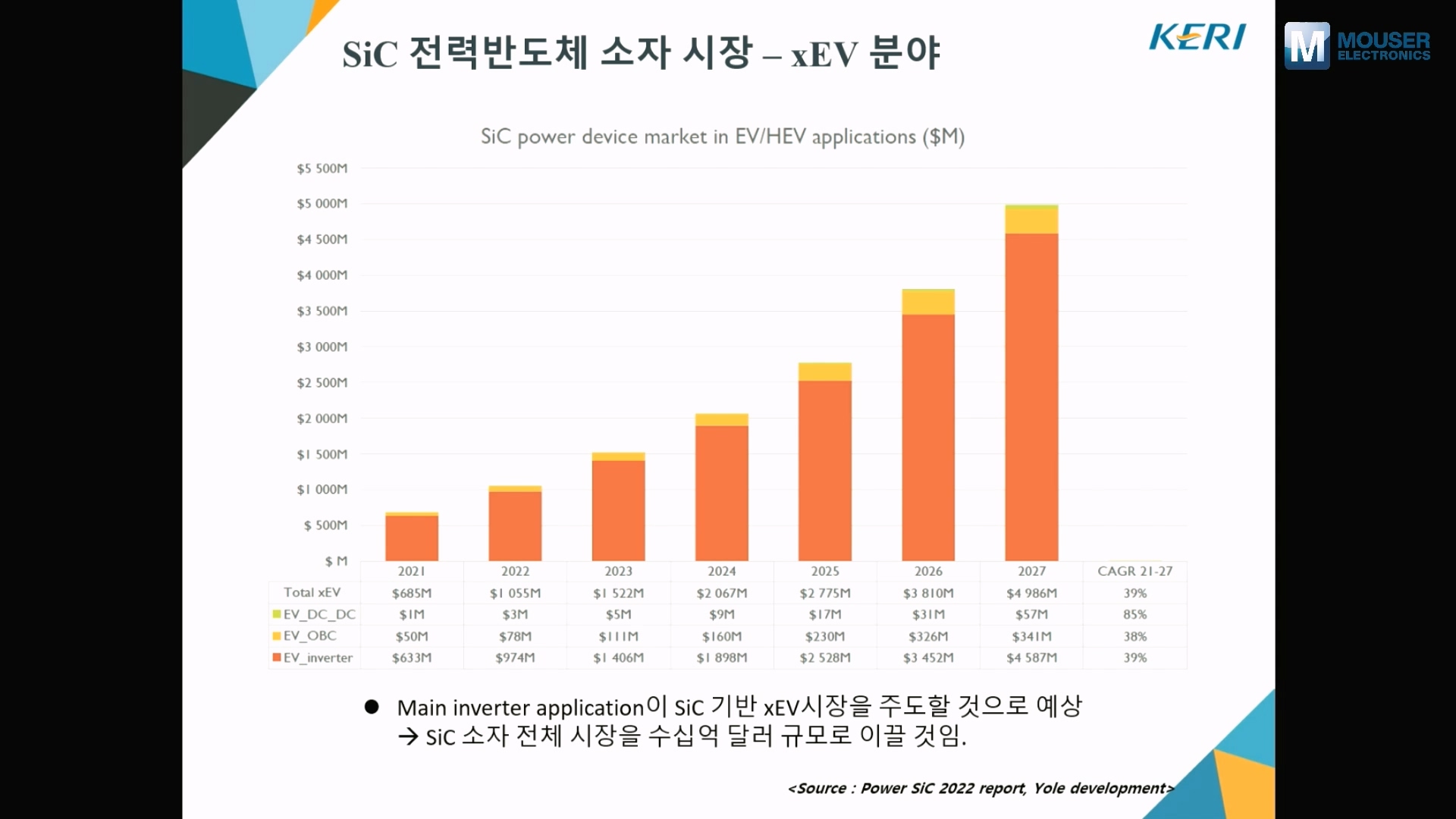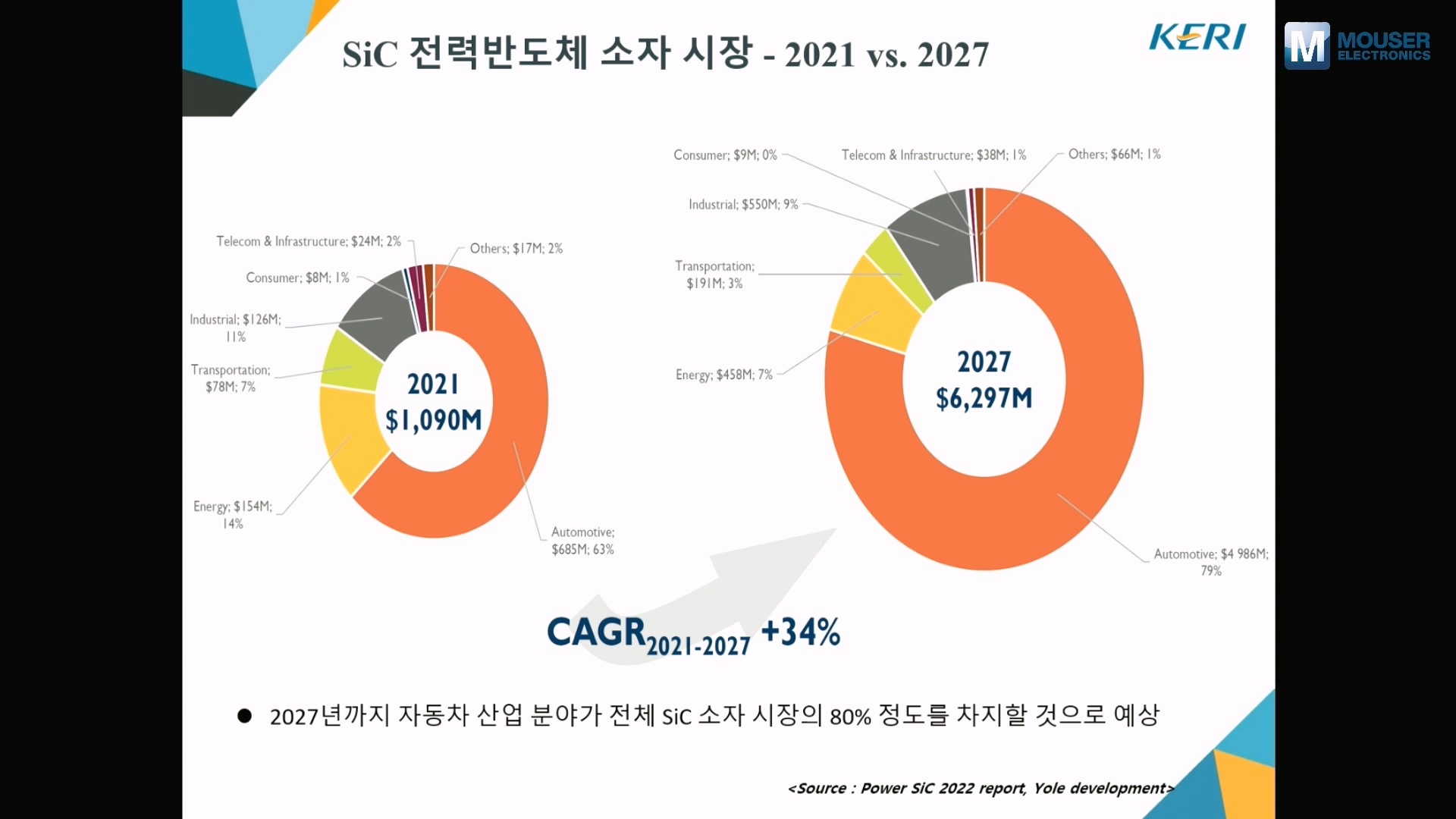김형우 한국전기연구원 센터장은 지난 18일 마우저 주최, e4ds 주관 ‘마우저 파워세미나 2023’에서 ‘국내외 SiC 전력반도체 기술개발 동향 및 시장 현황’를 주제로 특강을 진행했다.
인버터, SiC 전력반도체 소자 시장 92% 차지
800V 배터리 솔루션, SiC 모듈 적용 가속화
전기차 인버터에 적용되는 SiC 모듈이 SiC 시장을 꾸준히 주도해 나갈 것이라는 전문가의 분석이 나왔다.
김형우 한국전기연구원 센터장은 지난 18일 마우저 주최, e4ds 주관 ‘마우저 파워세미나 2023’에서 ‘국내외 SiC 전력반도체 기술개발 동향 및 시장 현황’를 주제로 특강을 진행했다.
김 센터장은 SiC 시장은 2020년 6억9,600만달러에서 2027년 63억달러로 성장할 것이라는 전망과 함께 자동차 산업 분야가 SiC 소자 시장의 70 ~ 80%을 차지할 것으로 예상했다.
SiC가 전기차에 이용되는 주요 애플리케이션은 인버터다.
2022년 SiC 전력반도체 소자 시장 10억5,500만달러 중 인버터가 9억7,400만달러로 92%를 차지하고 있다.

800V 배터리 솔루션으로의 전환 시도로 인해 메인 인버터가 고전압으로 개발되면서 SiC 모듈 적용이 가속화될 것으로 전망된다.
김 센터장은 인버터가 SiC 소자 전체 시장을 수입억 달러 규모로 이끌 것으로 내다봤다.
SiC 소자 형태별 점유율을 살펴보면 EV와 HEV 인버터 및 충전기 분야와 철도 및 수송 분야에 많이 들어가는 형태인 Full SiC 전력 모듈이 70% 가까이 차지하고 있고, 유지될 것으로 전망된다.
소자 종류별로 살펴보면 온보드차저와 DC/DC 컨버터는 모듈 형태가 아닌 트랜지스터, 다이오드 형태가 적용될 것으로 예상되고 있다.
DC/DC 컨버터의 경우 600V면 충분하기 때문에 당분간은 Si 기반 MOSFET이 적용될 것으로 보인다.
xEV의 판매량은 연평균성장률 22.7% 보이며 2027년에는 3,500만대가 판매될 것으로 예상된다.
특히 전기차 판매 증가에 따라 필요한 SiC 디바이스의 판매량도 동반성장할 것으로 예상된다고 전했다.
충전 인프라 분야에서의 SiC 전력반도체 소자 시장을 살펴보면 전기차와는 다르게 모듈보다 개별소자가 많이 들어가는 모습을 보인다.
그 중에서도 다이오드가 가장 많은 시장을 차지할 것으로 예상된다.
다만 배터리가 800V로 넘어가게 되면 충전기에도 모듈이 들어가야 할 필요성이 있기 때문에 800V 배터리 보급이 시작된다면 고속충전기 분야에는 SiC 모듈이 적용될 것으로 전망된다.
EV 충전기 분야 시장에서 가장 많이 요구되는 사항은 하이 파워 DC 충전기다.
SiC 전력반도체 소자도 이에 적합한 소자 개발 형태로 기술 개발이 이루어질 것으로 보인다.
하이 파워 DC 충전기가 필요한 이유는 현재의 500km 한계를 뛰어 넘는 주행거리에 대한 강력한 시장 요구를 충족시키기 위함이다.
현재 충전기로는 위를 만족시키는 배터리를 충전하는 데 걸리는 시간이 너무 오래 걸린다.
하이 파워, 스피드 DC 충전기를 만들어야 하고 이를 위해서는 SiC가 들어가야 한다는 주장에는 모두가 동의하고 있다.
추후 전기차 시장에서 늘어날 상용차(5톤 이상 트럭)의 배터리 용량을 감당하기 위해서도 SiC의 수요는 필수적일 것이라는 분석이다.
한편 Yole development에 따르면 2022년 기준 실리콘이 93%, SiC가 6.1%를 차지했으나 2026년 SiC가 13.2%를 기록할 수 있을 것이라는 전망이 나오고 있다.
파워서플라이, UPS가 초기 시장을 주도했다면 현재 SiC 시장을 이끄는 주요 애플리케이션은 전기차 분야이며 계속해서 SiC 시장 이끌어 나갈 것으로 분석된다.
김형우 센터장은 또한 철도, 수송 분야에 SiC 디바이스 적용이 예상되며 일본은 이미 테스트 중이라고 전했고, 장기적으로 보았을 때 풍력 발전에도 적용될 것으로 내다봤다.

